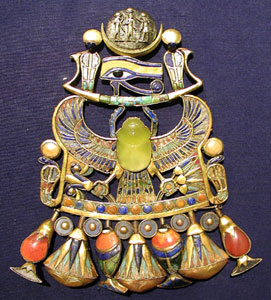
The antechamber of the tomb of Tutankhamun was described by Carter as being in a state of “organized chaos”, containing around seven hundred items including the components of four chariots, a collapsible sunshade, a number of senet boards, four ritual couches, a gilded wooden half-length bust of Tutankhamun wearing a flat crown, and two near life-size wooden figures that flanked the north wall in which the concealed entrance to the burial chamber was located.
One statue depicted Tutankhamun wearing the Nemes head cloth. The other represented his ka wearing an Afnet headdress. Both have skin coloured with black resin (symbolizing regeneration) and hold a staff and mace. Their clothing and jewellery are gilded with gold and their sandals and uraei are made of gilded bronze. It is thought that after the first tomb, robberies some of the goods originally stored here were moved to KV 54.

The burial chamber contained a series of gilded wooden shrines which almost entirely filled the room. Squeezed in beside the shrines Carter found eleven paddles for a solar boat, containers for perfumed oils, and lamps decorated with images of the God Hapi. The annex leading from the burial chamber was used to store perfumed oils and ointments along with food and wine.
The outer sarcophagus was made from two slightly different coloured blocks of granite. It seems that the lid did not originally match the body of the sarcophagus, perhaps being intended for the burial of a different pharaoh. At each corner one of Isis, Nephthys, Serqet (Serket), and Neith protect the body of the king.

Inside the sarcophagus a further three mummiform sarcophagi enclose the body of Tutankhamun, the innermost is composed of 110.4 kg of pure gold.
Inside the last sarcophagus lay the mummy, wearing the luxurious funeral mask crafted from gold, lapis lazuli, carnelian, quartz, obsidian, turquoise, and glass. It is one of the most famous pieces of Egyptian art ever to be recovered.

Inscriptions on a few of the treasures discovered in the tomb of Tutankhamun had clearly been altered for the burial. It is unclear in some cases whether the inscriptions were altered to reflect the change in his name from Tutankhaten to Tutankhamun, or whether they were in fact recycled from the burials of earlier pharaohs (a practice which was not uncommon).
In some cases (such as that of the middle coffin and the canopic cofinettes) the facial features differ noticeable from other images of Tutankhamun and clearly depict an older man with more angular features. It is generally agreed that these items initially belonged to Smenkhare.

It is often proposed that Smenkhare was the brother or father of Tutankhamun, but the strange condition in which the mummy in KV55 (who some believe to be Smenkhare) was found does raise the question of when these goods were appropriated for Tutankhamun and whether the person in charge of Tutankhamun’s burial (most likely Ay) was also responsible for the damage done to the mummy in KV 55.

Many of the objects in the treasury were originally discovered by Carter but were not opened or removed from the tomb. In 2007, further exploration of this chamber recorded that it contained eight baskets of fruit from the Doum Palm (also known as the gingerbread tree or thebaica). This tree was originally native to the Nile valley and was traditionally offered at funerals.
Archaeologists also discovered fifty clay pots marked with Tutankhamun’s official seal which may have contained money for the pharaoh to use in the afterlife. These have not yet been opened.

One of the jars recovered from his tomb still had the remnants of a perfumed oil within it. The perfumed ointment found in the tomb of Tutankhamun was a combination of pure coconut oil with spikenard and frankincense.
The mummy of Tutankhamun still rests in his tomb within a temperature-controlled glass case. In November 2007, the face of Tutankhamun was revealed when his mummy was removed from its golden sarcophagus for display in a climate-controlled glass box (to prevent decomposition as a result of the humidity and heat generated by tourists).
- Tomb of Tutankhamun; page one
- Tutankhamun
- Tutankhamun cache (KV 54)
- Was Tutankhamun murdered?
- “Curse” of Tutankhamun’s tomb
- Ankhesenpaaten (Ankhesenamun)
- Amarna Royal Family
- Amarna Religion
- Amarna Letters
Bibliography
- Bard, Kathryn (2008) An introduction to the Archaeology of Ancient Egypt
- Kemp, Barry J (1991) Ancient Egypt: Anatomy of a Civilisation
- Van Dijk, Jacobus (2000) “The Amarna Period and Later New Kingdom”, in The Oxford History of Ancient Egypt Ed I. Shaw
- Reeves, Nicholas and Wilkinson, Richard H. (1996) The Complete Valley of the Kings
- Strudwick, Nigel and Helen (1999) Thebes in Egypt
Copyright J Hill 2009